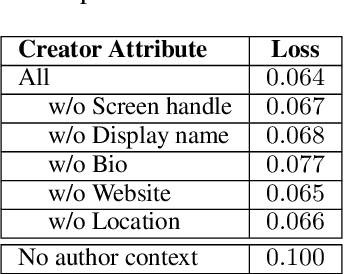Tanvir Amin
SocialQuotes: Learning Contextual Roles of Social Media Quotes on the Web
Jul 22, 2024Abstract:Web authors frequently embed social media to support and enrich their content, creating the potential to derive web-based, cross-platform social media representations that can enable more effective social media retrieval systems and richer scientific analyses. As step toward such capabilities, we introduce a novel language modeling framework that enables automatic annotation of roles that social media entities play in their embedded web context. Using related communication theory, we liken social media embeddings to quotes, formalize the page context as structured natural language signals, and identify a taxonomy of roles for quotes within the page context. We release SocialQuotes, a new data set built from the Common Crawl of over 32 million social quotes, 8.3k of them with crowdsourced quote annotations. Using SocialQuotes and the accompanying annotations, we provide a role classification case study, showing reasonable performance with modern-day LLMs, and exposing explainable aspects of our framework via page content ablations. We also classify a large batch of un-annotated quotes, revealing interesting cross-domain, cross-platform role distributions on the web.
Creator Context for Tweet Recommendation
Nov 29, 2023



Abstract:When discussing a tweet, people usually not only refer to the content it delivers, but also to the person behind the tweet. In other words, grounding the interpretation of the tweet in the context of its creator plays an important role in deciphering the true intent and the importance of the tweet. In this paper, we attempt to answer the question of how creator context should be used to advance tweet understanding. Specifically, we investigate the usefulness of different types of creator context, and examine different model structures for incorporating creator context in tweet modeling. We evaluate our tweet understanding models on a practical use case -- recommending relevant tweets to news articles. This use case already exists in popular news apps, and can also serve as a useful assistive tool for journalists. We discover that creator context is essential for tweet understanding, and can improve application metrics by a large margin. However, we also observe that not all creator contexts are equal. Creator context can be time sensitive and noisy. Careful creator context selection and deliberate model structure design play an important role in creator context effectiveness.
 Add to Chrome
Add to Chrome Add to Firefox
Add to Firefox Add to Edge
Add to Edge